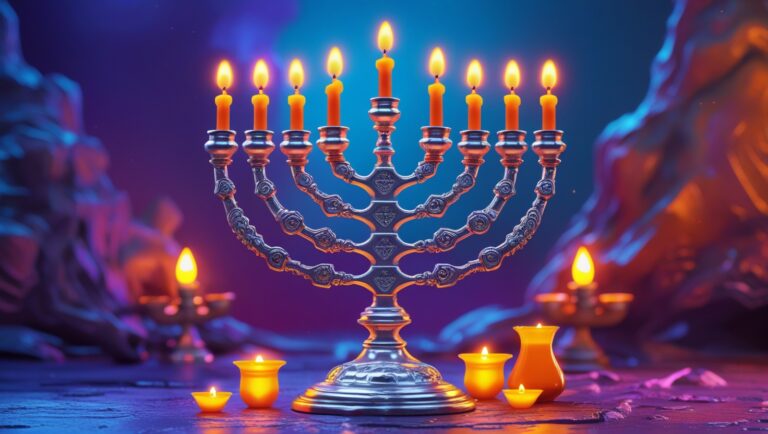Literature often highlights the pivotal role of men and their achievements, sometimes overshadowing the significant contributions of Jewish women.
There’s an intricate dynamics between men and women in everyday life. Men typically represent the external aspect of the world, focusing on outward expansion, progress and work, aligning with the six working days of the week.
Conversely, the female dimension leans toward the internal realm, emphasizing “being”, harmony, and the observance of Shabbat. As the sages have wisely noted, “One who doesn’t work [for] Shabbat, what will he eat on Shabbat?” On Shabbat, one refrains from work to tap into the inner spirituality cultivated throughout the week.
This paradigm is most visible when we consider that the 6 days of the week we lift up sparks from the Partzuf of Ze”ir Anpin (the 6 Sephirot: Chesed, Gevurah, Tiferet, Netzach, Hod and Yesod), while on Shabbat we lift up sparks of the Sephirah of Malkhut.
Recognizing and valuing these distinctions allows us to navigate life more effectively and determine when to employ each mode. It also enables us to appreciate each of our roles.
According to the teachings of the Arizal (Gate of Reincarnation, 2:2), Jewish women do not reincarnate as men. They have already completed their Tikkun (rectification) in this world and are here to assist their spouses in their own journeys. Nevertheless, in accordance with Jewish Law, women enter the realm of men through marriage, establishing boundaries for their ever-expanding desires and wills to achieve this mutual goal.
A Midrash on Jewish Women
A well-known Midrash vividly conveys this concept. The sages recount the story of a righteous man and a righteous woman who were married for a decade but had not been blessed with children. In accordance with Jewish Law, they decided to part ways. The righteous man subsequently wed a woman of ill repute, while the righteous woman married a wicked man. Remarkably, the outcome was quite unexpected—the wicked woman’s influence transformed the once-righteous man, and the righteous woman’s impact led her newfound wicked husband onto the path of righteousness.
This narrative underscores the powerful influence a woman wields in her marriage and, by extension, in society as a whole. It is worth noting that even the exalted Ba’al Shem Tov was known to have said, “Had my first wife been alive, I could have ascended to Heaven in a chariot of fire, akin to the departure of Eliyahu the Prophet from this world.
Consequently, according to Biblical Law, Jewish women are exempt from the obligation to marry, although the Rabbis encouraged marriage to avoid arousing suspicion. As the quintessential receivers, women already fulfill their role in Creation with fewer Mitzvot.
This grants them the opportunity to direct their focus not solely towards the study of Torah, except for the laws that pertain to them, but also towards prayer and the inner work of the heart. The act of prayer naturally aligns with the feminine mode of “being.” When one prays, they aspire to become a vessel for Hashem’s benevolence that flows from above.
While the “game” might seem unfavorable since men are able to study more Torah, Rabbi Chaim Vital explains in Sha’ar HaGilgulim that women get the merit and levels of souls that their husbands attain automatically.
The Power of Modesty
Throughout Torah, Jewish women are celebrated for their remarkable power in prayer and their willingness to make selfless sacrifices for the greater good of the nation. Renowned heroines like Sarah, Rachel, Miriam, Yael, and Esther were exemplars of this approach, centering their efforts on prayer, conducting themselves with modesty, and often working behind the scenes.
They embodied the feminine quality of Emunah (Faith), enabling them to triumph over adversaries and usher in salvation.
The emphasis on maintaining a discreet presence is the foundation for the sages’ guidelines on modesty (tzniut). It is also one of the reasons why Jewish women are ideally encouraged not to assume positions of overt authority. Being in the public eye and excessively involved in public life can potentially diminish the potency of their unique strengths.
As mentioned before, women parallel the Sephira of Malkhut which, while being holy, is unfortunately the closest to the reach of the forces of evil. Being modest and avoiding men’s lustful gaze, along with other harmful influences is therefore one of the most powerful protection and source of merit for them, even though men are also required to be modest and not show certain body parts. One merely needs to look at pictures of the Baba Sali, one of the greatest Kabbalists of the previous century, to see that he doesn’t show a single strain of hair (though this is not Halacha).
Jewish women reveal to us the Shechina
The innate qualities of women, characterized by their tenderness and nurturing nature, come to the forefront in their vital role as mothers and as the bearers of the next generation. Interestingly, the Hebrew word for womb, “Rechem,” shares the same root letters as the word for compassion, “Rachamim.” When a woman fulfills this crucial yet sometimes undervalued role, she is essentially “being.”
Rachamim/compassion is greater than Chesed/lovingkindness in that the former is given freely to everyone, while the latter is given only to those who deserve it. This is what a woman is doing when she is sustaining her child, being a nurturer and giving freely without any concern whether he’s deserving or not.
It’s worth noting that, according to Kabbalah, the Sephirah of Malkhut, through which God expresses Himself, is also depicted as “feminine”. Righteous Jewish kings like David HaMelekh have consistently strived to become complete vessels, wholly open to receiving God’s guidance in order to govern the nation. Their focus was almost entirely devoid of personal self-interest.
By adopting this feminine role, they aimed to bring justice and guide the people toward their ultimate purpose. In essence, they conveyed the message, “We are receivers from Hashem, and so should you be!”
The significance of Jewish women’s influence cannot be underestimated, especially with the growing recognition of the female mode of “being” in society at large. As times evolve, the power inherent in this mode gains greater importance since the Kingdom of Hashem is being revealed.
It is essential, however, that this power be directed towards holiness and goodness, as this is what will ultimately pave the way for the final redemption, as our sages have repeatedly emphasized in the Talmud and Midrash.
A peek into the spiritual worlds
Each of the four worlds – Atzilut, Beriyah, Yetzirah, and Assiyah – contains five spiritual systems (called Partzufim) which require rectification. This rectification can occur at any given moment, through the observance of Mitzvot, or over longer periods marked by special occasions such as Rosh Hashanah, Yom Kippur, Sukkot, and Shmini Atzeret. The spiritual work we engage in over the course of these 22 days represents a macrocosm of the daily Tefilah (prayer).
When we successfully repair a specific system, it allows Hashem’s Light and Mokhin to flow downward, with the lowest system known as the Shekhinah, or the Sephira of Malkhut.
The Shekhinah holds the crucial role of receiving Light from the higher systems and channeling it down to the lower worlds. In a deeper sense, the waxing and waning of the moon is explained as associated with the Shekhinah’s need to descend to the world beneath and sustain it, in accordance with Hashem’s command to “Go and diminish yourself” which happened on the 4th day of Creation.
At times, the Shekhinah ascends to replenish itself and then descends to “bring food to her house and laws to her maidens,” as we read in the Eshet Chayil song.
Essentially, the Shekhinah represents the immanent aspect of Hashem’s Providence and is the one who effects judgments, bring salvation and sustains Creation. The male counterpart is referred to as Ze’ir Anpin, or “small face” in Aramaic, and it embodies Hashem’s transcendent aspect of Divine Providence. Our engagement with Torah, Mitzvot, and Tefillot is focused on the rectification and union of these manifestations. This is one of the meanings of the word “Tikkun” (rectification).
The Holy Zohar elucidate that Kabbalah unveils the secret of M’an (“mayim nukvin,” the feminine waters) and M’ad (“mayim dukhrin,” male waters).
In spiritual terms, the former represents our desire to serve Hashem, while the latter symbolizes the abundant Light that descends from above. The mayim nukvin are indispensable for the purpose of raising the fallen sparks back to their source, and once we reach a critical mass of Tikkunim, we enter the reality of the World to Come.
At first glance, it might appear that there is a distinction between these two “waters.” However, a fundamental aspect of our spiritual service in this world is to recognize that it is all about unity with Hashem. Importantly, the responsibility for elevating the mayim nukvin, the “feminine” aspect in the relationship with Hashem, rests on our shoulders
Everything we possess, whether it be wisdom, health, wealth, protection, victory over adversaries, or even prophecy, is ultimately a product of the extent to which the Shekhinah receives Divine Light from above.
Notable examples of female heroism in the Torah
Having said all that, Jewish women provide us with valuable insights into the workings of the Shekhinah, often challenging our perspectives in intriguing ways.
We observe that, in many instances, women undertook actions that were generally forbidden, but they did so with temporary consent from Hashem. In Tractate Ketubot 22a, the sages impart the wisdom that “the mouth that forbids is the mouth that permitted,” a principle frequently demonstrated in the lives of Jewish women from the Tanach.
The prophetess Dvorah lived in a time period that was less than two centuries removed from the conquest of Eretz Yisrael. Following the passing of Yehoshua, the people’s Emunah (faith) waned, leading to the worshipping of idolatry. It was the resolve of the Judges that saved the people from their adversaries, particularly the Canaanites and Philistines, and brought about a semblance of peace.
Dvorah was one of these Judges, a position that seemed to defy the Halachic directive that Jewish women’s judicial decisions are not binding. While one might argue that she functioned as a spiritual leader, the level of respect and authority she commanded at the time was truly remarkable.
Some skeptics might consider Dvorah an anomaly or a unique occurrence. However, even before her time, Rahav, who was traditionally regarded as a harlot, aided Yehoshua in his conquest by sheltering his two spies on her roof. Rabbi Chaim Vital, in Sha’ar HaGilgulim, presents an intriguing perspective, suggesting that Rahav possessed a remarkably elevated soul, one that merited her marriage to Yehoshua.
It might prompt the question: how could such a righteous figure as Yehoshua marry her? Some sages provide an explanation that Rahav was not, in fact, a harlot, but rather a provider of sustenance to others, and the Hebrew words for “sustenance” (mazon) and “harlot” (zonah) have a significant linguistic similarity.
Furthermore, the teaching that Rahav (רחב) was later reincarnated as Hever (חבר), Yael’s husband, and subsequently as Chana, who subtly alluded to the name Rahav in her exultant prayer to Hashem, adds an intriguing layer to her story. Rahav was instrumental in aiding the Jewish conquest of Yericho by hiding the spies Caleb and Pinchas in her house.
Moving ahead in history, we encounter Beruria, the daughter of Rabbi Chaninah ben Tradyon and the brilliant wife of Rabbi Meir Ba’al HaNess. She gained considerable renown for her ability to challenge and stump the rabbis of her time. Beruria’s sharp intellect and skill in delivering rebukes were widely acknowledged.
However, her life took a tragic turn when she inadvertently mocked one of the Rabbi’s teachings. This act, considered her sin and subsequent punishment, offers insight into her remarkably high spiritual level. In fact, her inner strength was evident in her ability to bear the sorrow of losing their two sons and refrain from revealing this tragedy to her husband, sparing him much pain.
The higher one gets, the more caution one should exercise in his Avodat Hashem.
Purim deserves special mention
The story of Purim serves as an excellent example of the principles we’re discussing.
Esther assumes the central role in the endeavor to save the Jewish People, willingly placing her life (and purity) on the line. At the outset of the Megillat Esther, Haman “prophetically” declares, “Yeshno Am Echad Mefuzar” (there’s one people scattered), as part of his scheme to convince King Achashverosh.
The Arizal interprets the word “Yeshno” (there is) as “Yoshen” (asleep), noting the similarity in their letters. In Sha’ar HaKavanot, Rabbi Chaim Vital elaborates on this concept, explaining that Haman, a skilled astrologer, recognized that Ze’ir Anpin was, in a sense, “asleep.” The Mochin (flow of Divine consciousness) had not yet descended to awaken it, reflecting what occurs when we, as a collective, are in a state of dormancy.
This dynamic played out on a macrocosmic scale during the 70 years of exile, and it was a necessary step in the development of Malkhut/Shekhinah, mirroring the narrative of Purim.
Esther took on the leading role, while Mordechai operated from behind the scenes, working to cultivate himself and uplift the people. Ultimately, Mordechai emerged, and as the verse states, “went out from the presence of the king, clothed with a royal robe, and a great golden crown.”
This pivotal moment, commemorated annually, marked the culmination of the salvation of the Jewish people, during which we received an extraordinary Light that is concealed and only accessible on Purim. This was reminiscent of Ze’ir Anpin “waking up” and fighting the evil of Haman/Amalek.
Concluding remarks
The prophets, as foretold in Yeshaya 30:26, envision a future in which “the light of the moon will be like the light of the sun.” This signifies that the Shekhinah will radiate with the same brilliance as its male counterpart, representing the transcendent Divine Providence, and an abundance of Light will flow down freely, covering the face of the earth like the sea.
While the moon, symbolizing the Shekhinah and Jewish women, might need to descend from their original splendor at times, we can always appreciate their enduring efforts to sustain Creation.
We pray for their crown to be restored for all eternity, and may this happen swiftly in our days.
A female Rebbe:
The Chassidishe Rebbetzin, the Main of Ludmir:







